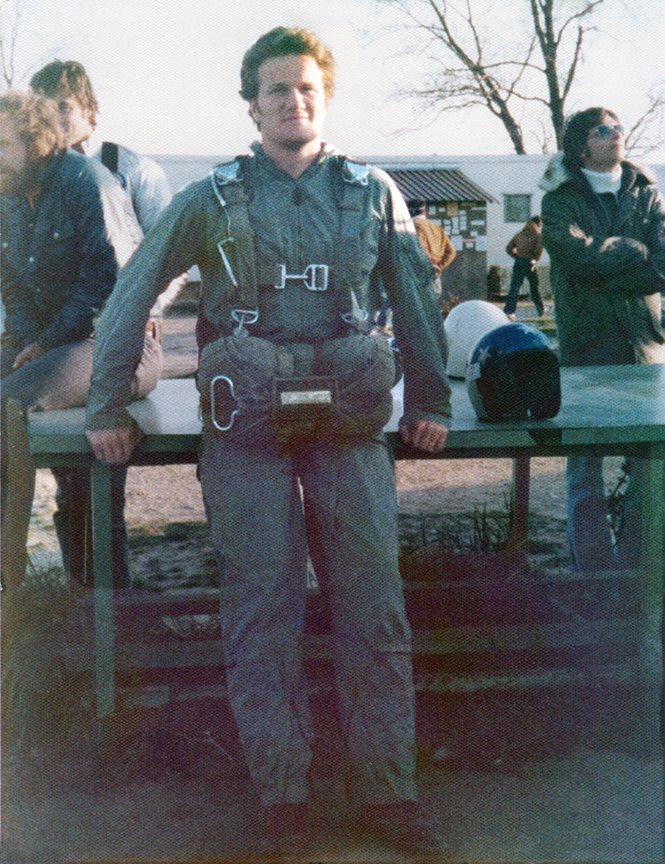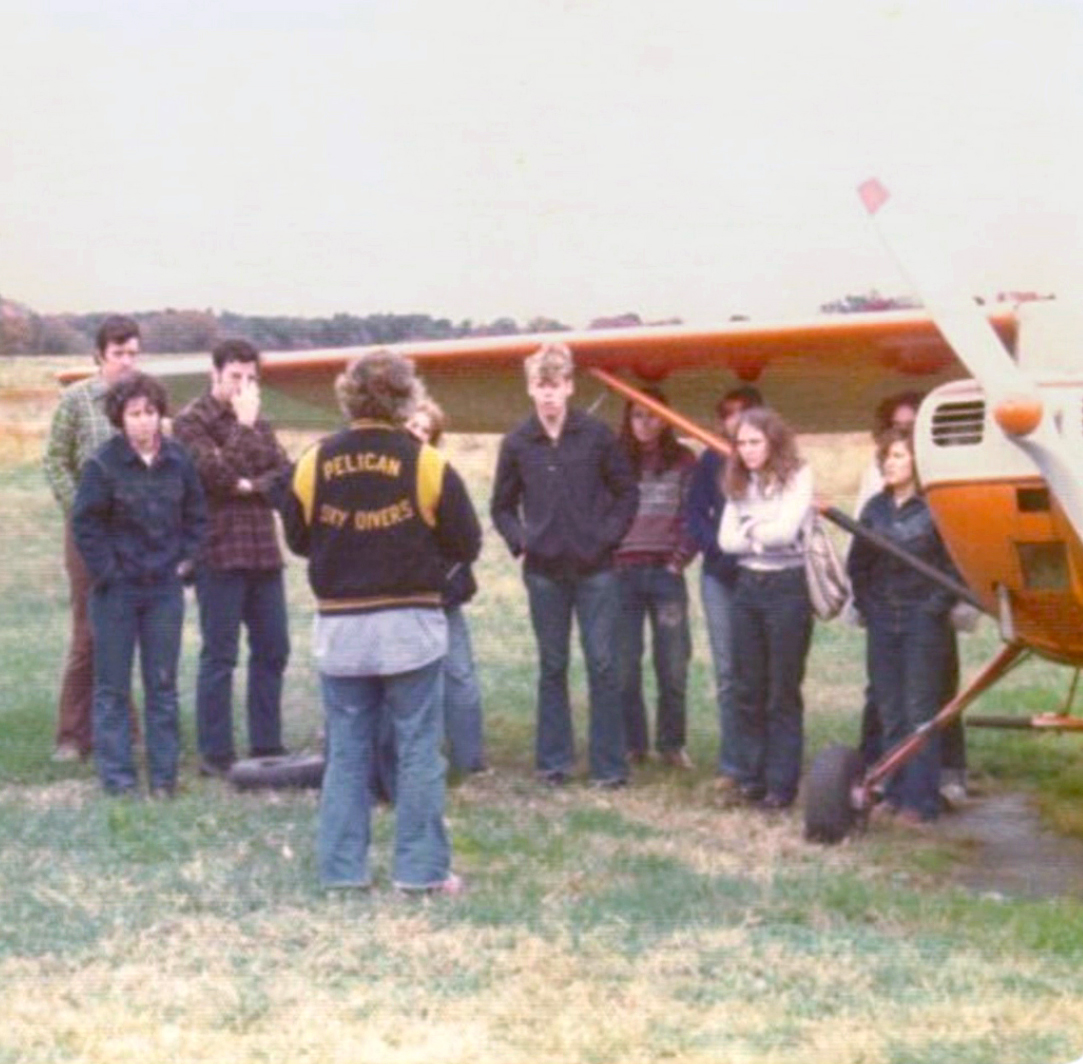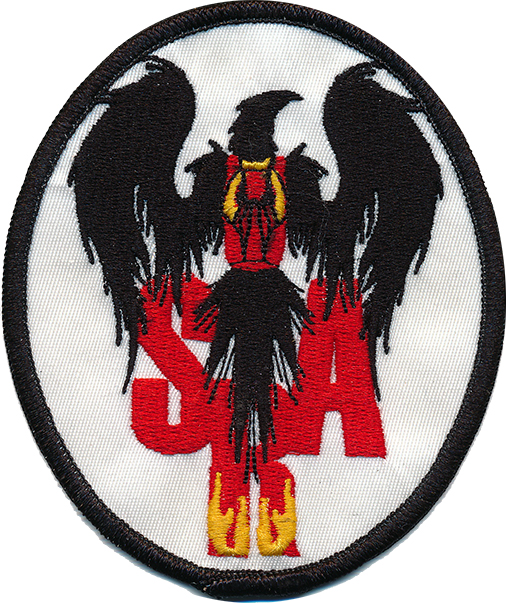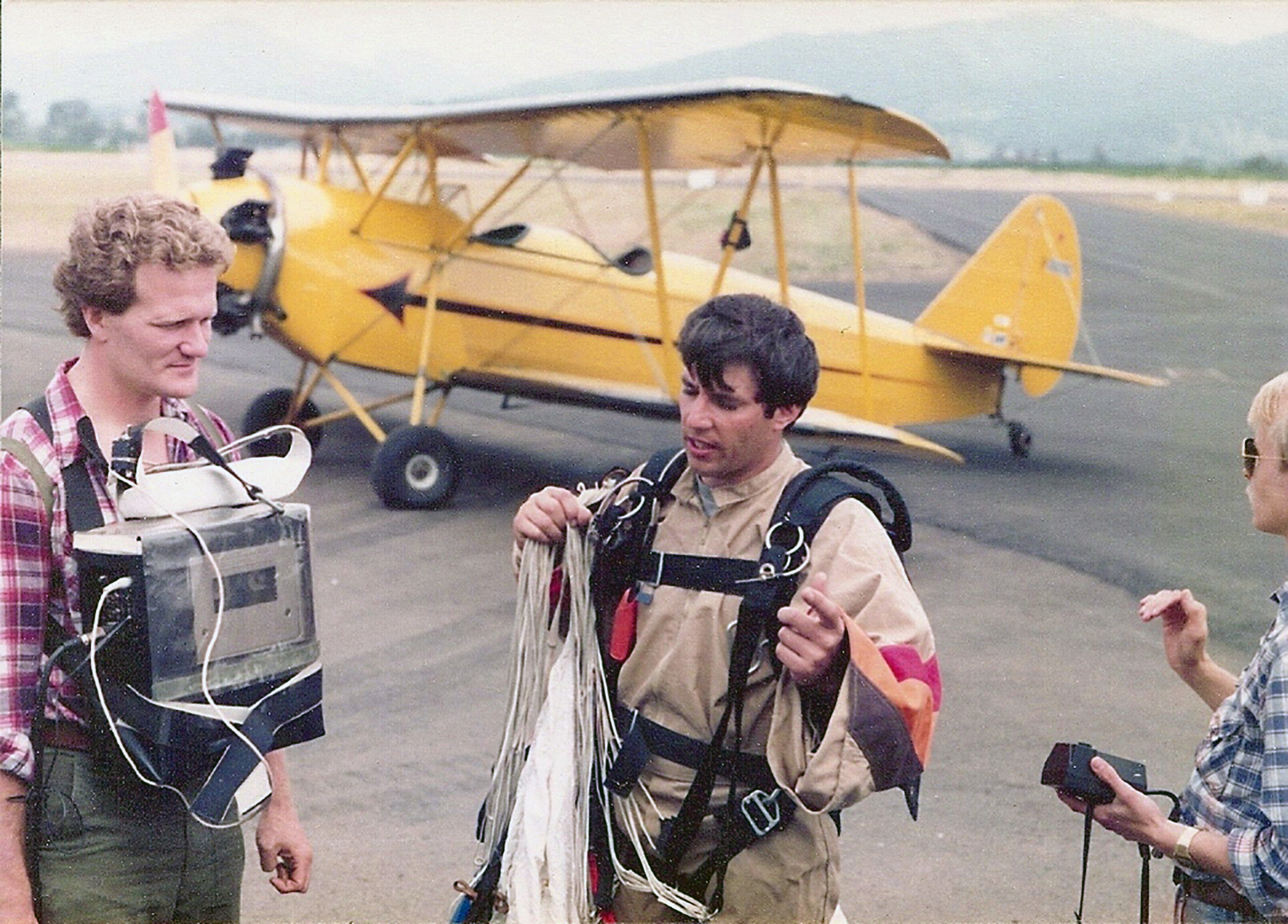
Skydiving
 December 04th, 2013
December 04th, 2013 Robert Crimmins
Robert Crimmins Adventure / Interests / Jobs, Aviation, Memoir, Skydiving, Sport Aviation, Writing
Adventure / Interests / Jobs, Aviation, Memoir, Skydiving, Sport Aviation, Writing 0 Comments
0 Comments
Rob and some buddies over Skydive Delmarva, Laurel, Delaware - July 4th Weekend, 2016
My First Parachute Jump
In 1961"Ripcord" premiered on network television. It was about two guys who made parachute jumps for a living. The services they provided were almost entirely fictitious but that didn’t matter to my brother and me. We didn’t watch every week for the stories. We wanted to see them in free fall and those shots were all real, taken either from cameras mounted to the jumper’s helmets or from airplanes.As a child I loved to jump off of things. In places in our neighborhood the seawall stood three or four feet high over beach sand so that was a good spot and in the woods we could leap from trees to be caught by nets formed of vines ten or twenty feet below. That was risky and there were times when I fell through to the ground but somehow I was never injured. We would leap from the tops of the channel markers in the Chesapeake Bay too. That venue allowed for compounding the fun because another compulsion some of us had was to reach the bottom of every body of water we swam in. Even when it was impossibly deep we would try.
In 1974, when I went to the University of Delaware, I discovered the skydiving club and that it only cost $35 to go through the one day training course and make a jump. Since seeing the jumpers on TV when I was six I assumed that soon after reaching adulthood I’d exit an airplane with a parachute like the characters in Ripcord and I thought David, my brother would too, but when I gave him the good news that we could do it he wasn’t interested, in fact he dismissed the idea as foolish. It was an early lesson in how what you think you know about others, even those who are close, can be very wrong.
Since David wouldn’t join me I asked my friend Gabe if he’d like to go. Gabe and I were on our high school wrestling team together, we’d worked together as high-rise window cleaners and we’d spent a lot of time doing things that teenagers do so it didn’t surprise me when he said yes.
We went to Ridgley, Maryland on September 21, 1975, to a grass strip airport called Pelicanland whose name was derived from the club that was the primary user of the facility, the Pelican Skydivers.
The ride from campus took about ninety minutes. If I’d had more life experience I might have turned back after seeing the place. The farm house that was there a few months before had burned down and had been replaced by a trailer so there were no permanent structures and the number of crashed airplanes nearly equaled those that were airworthy. It didn’t bear any resemblance to the airport in the Ripcord TV series but the University club and the Army ROTC sponsor deemed it safe so I assumed I was in good hands and as it turned out I was.
Click March 1962 Ripcord Comic to see the Dell Comic.
[image_shortcode type="one_half" title="Since David wouldn’t join me I asked my friend Gabe if he’d like to go. Gabe and I were on our high school wrestling team together, we’d worked together as high-rise window cleaners and we’d spent a lot of time doing things that teenagers do so it didn’t surprise me when he said yes.
We went to Ridgley, Maryland on September 21, 1975, to a grass strip airport called Pelicanland whose name was derived from the club that was the primary user of the facility, the Pelican Skydivers.
The ride from campus took about ninety minutes. If I’d had more life experience I might have turned back after seeing the place. The farm house that was there a few months before had burned down and had been replaced by a trailer so there were no permanent structures and the number of crashed airplanes nearly equaled those that were airworthy. It didn’t bear any resemblance to the airport in the Ripcord TV series but the University club and the Army ROTC sponsor deemed it safe so I assumed I was in good hands and as it turned out I was.
Click March 1962 Ripcord Comic to see the Dell Comic.
Jim McIntyre, “Mac”, a Maryland Eastern Shore native with a waterman’s accent, was our instructor. There was a lot of information to impart and Mac gave it all to us at a rapid pace. He allowed questions but he didn’t linger. We had to know how to board the airplane, how to move in it, how to exit, what to do outside the airplane, how to operate the parachute, and how to land. Those were the things that we would have to do but we were also taught what to do in case of an aircraft emergency and if the parachute malfunctioned. To learn all that in one day and then make a jump wasn’t easy but Mac got us through it.
Because of the United States Parachute Association requirements on what had to be taught and other restrictions, like the weather, the drop zone didn’t guarantee that everyone in the class would jump the same day as the course. As it turned out I was the last one in our class to jump that day and Gabe was the first one who didn’t. I returned for my second jump the following week and I made over one hundred jumps the next spring and summer but Gabe never went back and never did make a sky dive.
As my jumpmaster, Jim West, put the harness / container and reserve parachute on me I worried about what was going to happen. During the day I’d seen scores of parachutes open and people land without incident and the course was thorough so I felt good about my chances but I was still scared. By the time we climbed to 2800 feet and I scooted to the spot next to the door of the 170 Cessna the butterflies were beating furiously and when the door opened and I looked down I was very afraid. What I was about to do seemed most unnatural.
Despite the fear and the noise I heard the commands and followed the order to, “Get your feet out!”
Because of the United States Parachute Association requirements on what had to be taught and other restrictions, like the weather, the drop zone didn’t guarantee that everyone in the class would jump the same day as the course. As it turned out I was the last one in our class to jump that day and Gabe was the first one who didn’t. I returned for my second jump the following week and I made over one hundred jumps the next spring and summer but Gabe never went back and never did make a sky dive.
As my jumpmaster, Jim West, put the harness / container and reserve parachute on me I worried about what was going to happen. During the day I’d seen scores of parachutes open and people land without incident and the course was thorough so I felt good about my chances but I was still scared. By the time we climbed to 2800 feet and I scooted to the spot next to the door of the 170 Cessna the butterflies were beating furiously and when the door opened and I looked down I was very afraid. What I was about to do seemed most unnatural.
Despite the fear and the noise I heard the commands and followed the order to, “Get your feet out!”
The wind and engine noise were forces that resisted my will and movements but they didn’t prevent me from doing what Jim commanded, neither did the fear, which increased as I began to actually commit to the opposite of what my instincts were frantically trying to stop me from doing.
With the fear growing but under control I heard the next command. “Get OUT!”, so I stood on my left leg and rotated on that foot to get all the way out of the plane, face forward and take hold of the wing strut. There I waited for the final order to do what every neuron was telling me not to do. The sight of the ground below, the spinning propeller right in front of me and the deafening roar of the wind and the engine made it seem like a very long wait too.
When the order to, “GO!”, and the slap on the thigh came, I didn’t hesitate. Like a sprung trap I pushed off, arched by body and looked up at the airplane as Mac had told me. As I dropped, the static line, which was in Jim's hand and attached to a ring just inside the door frame played out. At the end of a very short drop the lower end of the static line opened the container and pulled the parachute out as Mac said it would and the sudden stop that he said to expect occurred, but what happened after all those anticipated and fully described events was a surprise. It was the quiet and the peace. The contrast between the roar of the wind blast and the fear of falling, with the silence and relief of being suspended in the air half a mile above the Earth was the most wonderful shock imaginable.
I could still hear the plane but barely and it faded to nothingness in seconds. Then there was almost no sound at all. Under a round parachute with almost no forward speed I was in utterly still air. Nineteen-years-old, suspended two-thousand feet above the world at sunset, in a slow descent, I was filled with a sense of accomplishment and the thrill of freedom. I was only able to enjoy it for a half-a-minute before more of Mac’s instructions had to be carried out but hanging there like that, motionless, quiet and safe after all the noise and anxiety was a wonderful sensation. Striving to recreate that feeling and those thirty seconds shaped the rest of my life.
With the fear growing but under control I heard the next command. “Get OUT!”, so I stood on my left leg and rotated on that foot to get all the way out of the plane, face forward and take hold of the wing strut. There I waited for the final order to do what every neuron was telling me not to do. The sight of the ground below, the spinning propeller right in front of me and the deafening roar of the wind and the engine made it seem like a very long wait too.
When the order to, “GO!”, and the slap on the thigh came, I didn’t hesitate. Like a sprung trap I pushed off, arched by body and looked up at the airplane as Mac had told me. As I dropped, the static line, which was in Jim's hand and attached to a ring just inside the door frame played out. At the end of a very short drop the lower end of the static line opened the container and pulled the parachute out as Mac said it would and the sudden stop that he said to expect occurred, but what happened after all those anticipated and fully described events was a surprise. It was the quiet and the peace. The contrast between the roar of the wind blast and the fear of falling, with the silence and relief of being suspended in the air half a mile above the Earth was the most wonderful shock imaginable.
I could still hear the plane but barely and it faded to nothingness in seconds. Then there was almost no sound at all. Under a round parachute with almost no forward speed I was in utterly still air. Nineteen-years-old, suspended two-thousand feet above the world at sunset, in a slow descent, I was filled with a sense of accomplishment and the thrill of freedom. I was only able to enjoy it for a half-a-minute before more of Mac’s instructions had to be carried out but hanging there like that, motionless, quiet and safe after all the noise and anxiety was a wonderful sensation. Striving to recreate that feeling and those thirty seconds shaped the rest of my life.
4 Way at Skydive Delmarva 8/31/13
The patch is my “Skydiver Resurrection Award”. It’s easily earned, requiring only that the jumper be out of the sport for ten years or more and has returned to make at least one more jump. The last jump I made before my absence was on July 1, 1995 with a Thai prince under slightly special circumstances. One of his bodyguards signed my log book in Thai script so it’s an unusual entry. I came back in 2012 after 6147 days without a jump. That matters because the number of days without jumping is the SRA award number.
I’m the jumper in the blue and black jumpsuit in the video, the third to enter the formation. I like it because it's from two cameras and it shows that I can still fly, not like the pros, but well enough to hang with the other Resurrecteds.
I’m the jumper in the blue and black jumpsuit in the video, the third to enter the formation. I like it because it's from two cameras and it shows that I can still fly, not like the pros, but well enough to hang with the other Resurrecteds.
Early 1980s Biplane Jump
"Flyin Bryan" Martell flew into the Tillamook, OR airport one day in 1984 (?) looking for paying passengers. Bill Giordano was the first. He wasn't the first to land with Bryan though because Bill is a skydiver and he would much rather jump out of even a perfectly good airplane than land in one.The video was recorded on the U_Matic deck strapped to my chest. It was a Panasonic that held an 18 minute cassette. The case, which I made out of balloon fabric, made it possible to shoot on the run but only for the young and agile. My camera, a JVC KY-1900, was almost as big as the deck
August 31, 2014 Wedding Demo
I was Bill's Best Man at his wedding, which was on a farm next to the Shanandoah River in Berryville, VA. Bill, Nancy Miller-Daly, Ben Wong and I jumped into it from 8000' AGL through a very beautiful sky.






















0 comments
Leave a comment